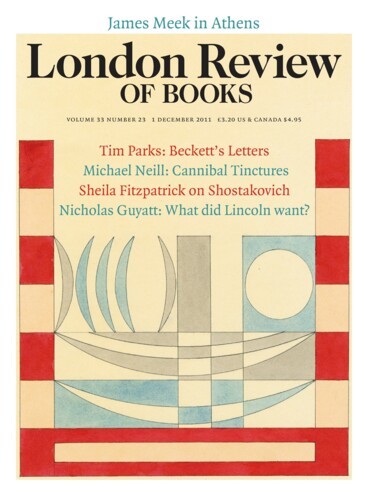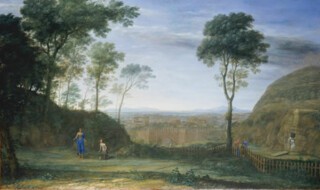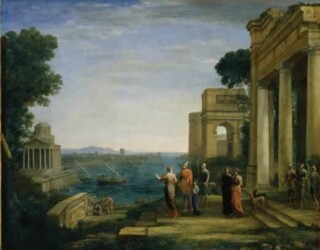The exhibition at the Ashmolean in Oxford until 8 January, Claude Lorrain: The Enchanted Landscape, brings to one gallery three of the most haunting canvases of the 17th century. One belongs to the museum: Ascanius Shooting the Stag of Silvia, which was probably still on Claude’s easel when he died in 1682, just as old as the century. A second is the National Gallery favourite The Enchanted Castle, identified by scholars as Landscape with Psyche outside the Palace of Cupid. Landscape with Christ Appearing to Mary Magdalen has been brought in from Frankfurt.
Is ‘haunting’ the word? In many ways there is nothing mysterious about Claude’s career. It is remarkable only in its steadiness. As a teenager he joined Rome’s large immigrant community of artists from northern Europe. By 1627 he had a niche in the landscape market these northerners had lately opened up. By 1637 he had pre-eminence in it, with commissions from the pope joining those from the French aristocracy. Thereafter his order book kept full and he simply went on working, changing studios only once in the rest of his life. Friends remembered a reliable and quietly loveable man, not much given to opinionising.
Claude would walk out of town and along the Tiber. The drawings in the show include discoveries made by pen and brush while looking at riverbanks, farmsteads, ruins and trees. They have a happy urgency, driven by a longing to memorise fleeting tonal relations so that, back in the studio, an invented arrangement of planes could be modulated until it looked like a scene observed. That is how the majority of the drawings here started – schemes to fill a saleable rectangle. Other artists had sketched en plein air before Claude, but he put in more hours, ‘lying in the fields before the break of day and until night in order to learn to represent very exactly the red morning sky, sunrise and sunset and the evening hours’, according to a memoir by Joachim von Sandrart. The effort paid off. Other artists were devising pastorals peopled by little figures to supply scale and traces of mythological significance, but Claude’s caught the eye for their greater ‘naturalness’.
Sometimes he invented pictures not with a pen but a burin: the exhibition extensively documents his forays into etching. They include a suite recording a pyrotechnic spectacle put on by the Habsburgs in Rome – Claude’s only departure from landscape, and a hesitant one at that. The most interesting prints draw inspiration, like so much in Roman landscape art, from the tiny paintings done in the early 1600s by Adam Elsheimer. Elsheimer’s images mull over a transition in feeling, from narrative and mythology towards space at its most abundant: his foreground figures become passive witnesses, as significance leaches away from their stories into the deep woods and far horizon. That polarity is echoed in Claude’s 1630s prints – The Ford, for example – and gains resonance from his innovative layering of tones.
Claude’s work in painting sets out on a more positivist foot, having shed all but the flimsiest narrative premises. Landscape has become the craft of arranging one plane behind another (this meadow, that slope, yonder valley) until you reach the infinite sky. The high art, you might say, lies in refining the transitions from plane to plane so exquisitely that the viewer’s imagination is drawn forever inwards and backwards. This high art of Claude’s turns on his matchless understanding of the way sunshine diffuses. And yet that sunlight carries no great symbolic or expressive weight (unlike, say, the light of his devotee Turner). His white paint satisfies by association: we all feel better for some sun, some country air, a clear view.
Still less do Claude’s objects have body. Strange geometrical flanges sometimes hug the canvas edge, nominally representing antique architecture: you only read them right when you realise they have no function except to obstruct or recede. His anatomy-free figure painting has always been a standing joke – he knew it, we’re told, but refused to subcontract the task. What you get instead of volume and inner structure is gorgeously variegated optical texture, an unsurpassed attention to the play of light on the fractal surfaces of foliage, rocks and water. Yet the underlying clearheadedness of the operation ensures that the canvas is never cluttered or fussy. Claude is at once greatly generous and greatly detached: all he is really thinking about is behind and before, recession and obstruction.
I see these lifelong good habits of his like those of a gardener steadily improving his plot, year on year; or a sitar-player forever finding his way into twinned raags. (Claude similarly paired up his canvases into morning scenes and evenings. The hang in the Ashmolean’s central gallery takes this into account, to beautiful effect.) Yet the art does change. The palette of this solitary and I suspect quite stubborn master shifts in the opposite direction to those of the studios around him. While 17th-century Italian painting preponderantly warms up, from the harsh bracing light of the Caravaggisti to the blowsy pinks and russets of the age of Solimena, Claude progressively turns the thermostat down.
It is as if Claude has at length seen beyond behindness and beforeness. After so many decades employing figures merely as comfortable gateposts for the imagination to lean on while admiring the view, he locates in them a new narrative necessity. Psyche, the maiden sat brooding in the foreground, relates to the far castle not just as dreamer to dream but as victim to destiny: something or other is fated to happen. The arrow that Ascanius, Aeneas’ son, is about to shoot will shatter the harmonies of archaic Latium, fomenting wars out of which Rome will rise. The Magdalen, venturing through a homely fence into a dewy hilltop garden, falls to her knees as it hits her that Jesus has overcome death. Down below, in a still sleeping Jerusalem, an unprecedented morning is about to begin.
Send Letters To:
The Editor
London Review of Books,
28 Little Russell Street
London, WC1A 2HN
letters@lrb.co.uk
Please include name, address, and a telephone number.



